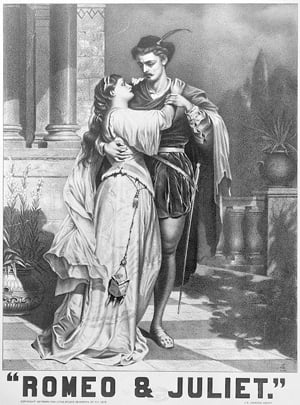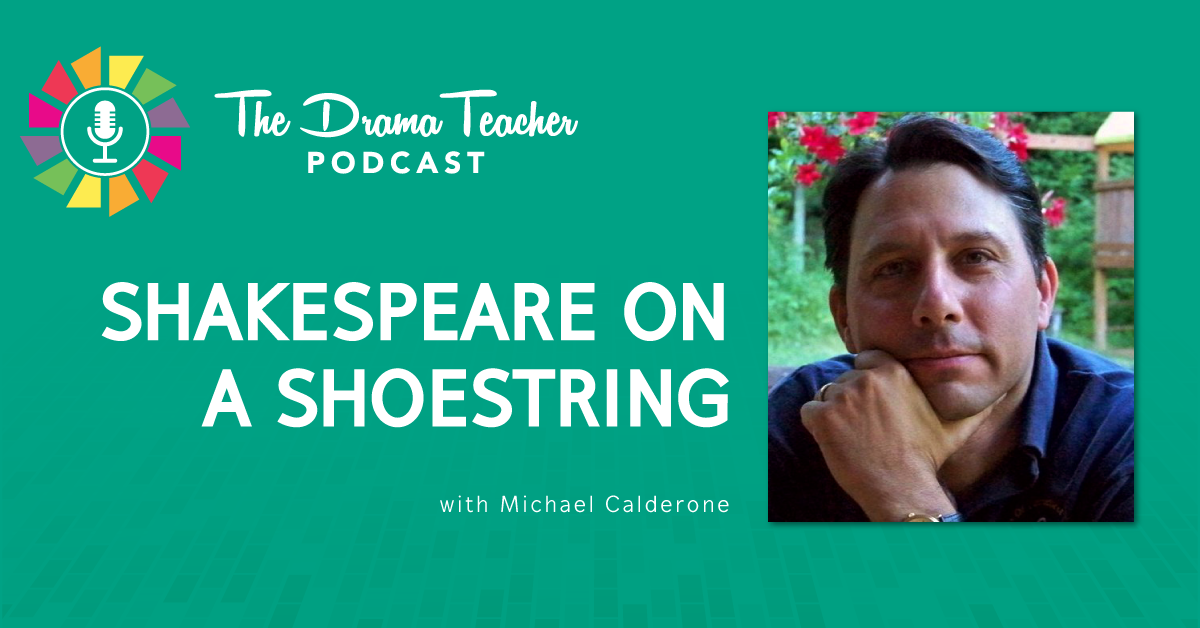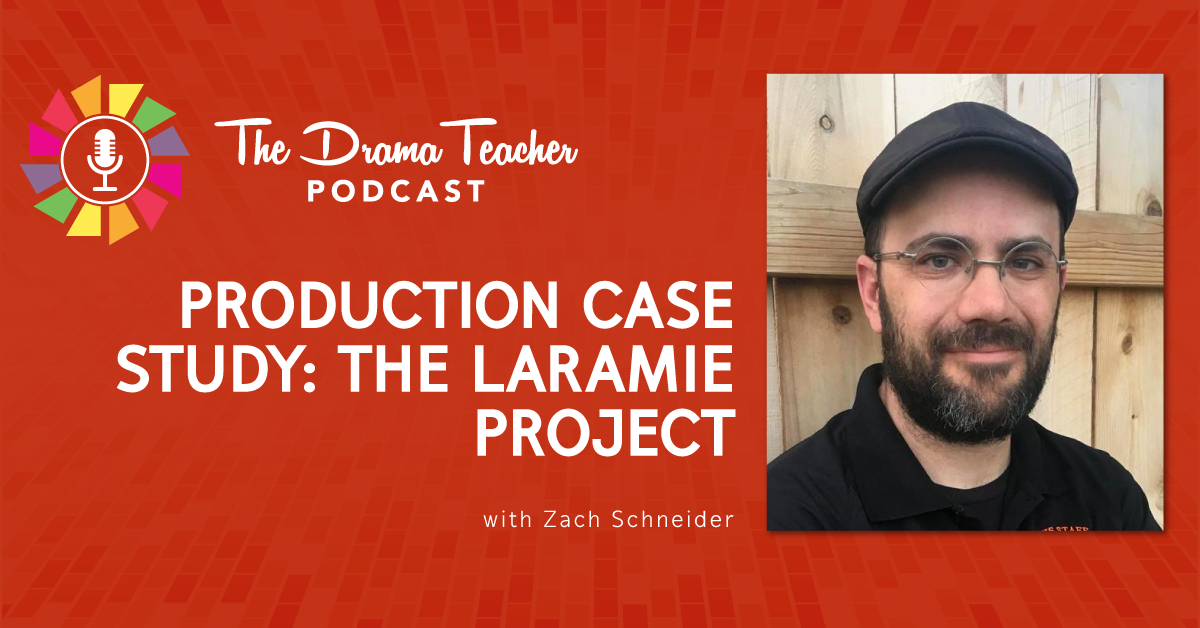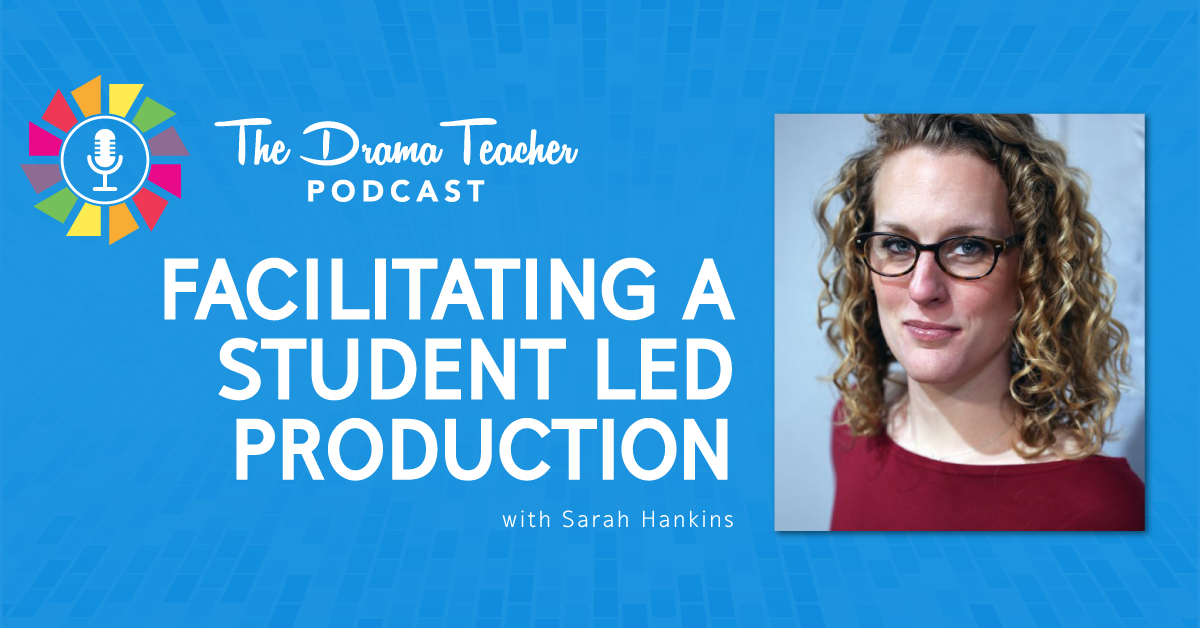Romeo and Juliet YouTube Fireside Chat
Episode 32: Romeo and Juliet YouTube Fireside Chat
Since our February and March… and April newsletters revolve around Romeo and Juliet, we thought it appropriate to do a YouTube Fireside Chat on the play. Lindsay and Craig discuss a variety of clips from different versions of Romeo and Juliet.
Clips discussed this podcast:
Olivia Hussey and Leonard Whitting
Romeo and Juliet first meet – Leonardo DiCaprio & Claire Danes
Sadly, this clip has since been removed from YouTube.
Balcony Scene – Leonardo DiCaprio & Claire Danes
Sadly, this clip has since been removed from YouTube.
Royal Shakespeare Company – Sam Troughton and Mariah Gale
Alessandra Ferri and Angel Corella in Prokofiev’s Romeo and Juliet
Subscribe to The Theatrefolk Podcast
Episode Transcript
THIRTY -TWO
Welcome to TFP, The Theatrefolk Podcast. I am Lindsay Price, resident playwright for Theatrefolk. Hello! I hope you’re well. Thanks for listening.
Today, it’s a YouTube Fireside Chat all about those crazy cats, Romeo and Juliet. But first, some THEATREFOLK News.
R and J! R and J! It’s R and J, all the way! See? This is what happens when I make stuff up on the fly. It sounds as ridiculous and dorky as it just did coming out of my mouth. All right! So, not only is Romeo and Juliet the focus of this podcast, it’s also the focus of our March newsletter. And yes, Romeo and Juliet was the focus of our February Newsletter. And yes, it’s going to be the focus of our April newsletter. This is not a three-hour tour I am on. This is a three-month extravaganza. Will I ever be done with this play? And it’s my fault. It’s totally my fault. It’s my fault because I love this – I love diving into a script, and just doing the analysis, and coming up with exercises and, before I know it, it’s the beast and the beast is 15 pages long and that’s too long and I haven’t even started on the language. I have not even started!
So, in February, we looked at the story of Romeo and Juliet. In March, it’s the characters and the relationships between the characters. And April will all be about the language – the language of Shakespeare, the language in Romeo and Juliet. And that’s it. It has to be. I cannot spend a quarter of the year on this one play. Well, I could, but I won’t. Anyway, it’s a good newsletter. It’s a great newsletter! I think that’s a totally backwards compliment that I really wanted to say here was that it’s fantastic. I love it. I love the exercises. It’s large because it’s a fascinating play, and there’s lots to talk about, getting knee-deep in with the characters and figuring out what they’re all about, I think it’s worthwhile. So, don’t fear the behemoth. Embrace it, or something like that.
And lastly, where, oh, where can you find this podcast? We post new episodes every Wednesday at theatrefolk.com and on our Facebook page and Twitter. You can find us on the Stitcher app AND you can subscribe to TFP on iTunes. All you have to do is search for the word Theatrefolk.
Episode Thirty-Two: YouTube Fireside Chat
Lindsay: Hello! Here we are, all snuggled up in front of our computer fire for our YouTube Fireside Chat.
Craig: Crackle, crackle, crackle, crackle, crackle.
Lindsay: I don’t need to introduce Craig.
Craig: Crackle, crackle, crackle, crackle.
Lindsay: He’s making fire noises!
Craig: Did you want another log on there or are we good?
Lindsay: You know what? I’m feeling a little bit chilly. Can you put another log on our fake computer fire?
Craig: I will do that.
Lindsay: Awesome, perfect, perfect!
So, for this episode, since I’m in the middle of my three-month behemoth extravaganza of Romeo and Juliet, we thought, well, why not include everybody into my little hell? Which it’s not – I’m really enjoying it. It’s just long, Craig. It’s very long that I’m working on this play.
Craig: It started out as one newsletter and then you came to me and then you said, “It’s getting kind of long and I have to cut it off,” and I said, “Okay, we’ll make it two newsletters.” And then, when you worked on the second one, you said it’s getting kind of long. I said, “Well, we should cut it into three newsletters.”
Now, I need you to promise me…
Lindsay: Yes.,
Craig: …in front of the entire world that you are not going to go beyond three newsletters.
Lindsay: Well, I already, in the intro for this podcast, I’ve already stated that I am cutting it off. So, now I’ve stated it twice so that means it must be true.
Craig: Okay.
Lindsay: This is going to be – no, it’s to print, that if it’s in print it must be true. But it’s going to be on the Internet so it must be true, right? Because everything…
Craig: Everything on the Internet is true.
Lindsay: Right.
So, just to keep this going, we’re going to talk about and we’re going to look at YouTube clips of Romeo and Juliet. And so, of course, we’re focusing on the two movies that were made – 1968, Zeffirelli, and also, the 1996 with Leonardo deCaprio and Claire Danes. We also have a ballet version in there.
And, just upfront, I am going to say we are not going to look at Westside Story. Yes, Westside Story is a movie version of an adaptation of Romeo and Juliet. But, Craig, you looked at the clips and it didn’t quite…
Craig: Well, we’re kind of focusing mostly on the balcony scene and I don’t know. I just don’t think that’s a great movie of the play. I think it’s a great play but I don’t think the movie’s all that good. She’s not even singing in it.
Lindsay: Awesome. So, yes, we know, and no, we’re not doing it.
So, the first one is the 1968 movie and we are, yes, we’re looking primarily at balcony scenes.
Lindsay: So, what did you think of this balcony scene?
Craig: When I saw, when you sent me the clip and I watched it, I remembered I actually watched this movie in high school.
Lindsay: I did, too. And, okay, so, I have a question for you because…
Craig: It was not censored when I saw it. This was an all-boys Catholic high school and it was…
Lindsay: Oh my, they must have flipped their lids.
Craig: …somewhat scandalous.
Lindsay: I see. My grade nine teacher stood in front of the television at that point.
Craig: Oh.
Lindsay: So, everyone knew that Olivia Hussey was topless at a particular moment but…
Craig: Oh, everyone knew in my class, I’ll tell you that.
Lindsay: So, when I looked at this, I have to say, this is kind of what I imagine Romeo and Juliet would look like. Sort of that it’s classical, it’s romance, it’s sort of breathless, it’s kind of childish.
Craig: Well, childish for sure because the characters are very young and the play takes place at a time where kids didn’t grow up quite so fast. So, what I really appreciated about the clip and these characters and the casting was that you really get a sense of how young they are…
Lindsay: Yes.
Craig: …and how reckless the choices they’re making are because of their incredible youth.
Lindsay: I’m not sure I would agree with the notion that they didn’t grow up as quickly. I think they were sometimes sheltered but, I think, in this time period, they would have been exposed to life and death from day one, I think.
Craig: Maybe not Juliet though.
Lindsay: Aha! Ha-ha-ha-ha! Except… Who – and this is something that I’ve really come to look at when I was studying the play and also comes up in the other two clips – who has she been listening to since the day she was born?
Craig: The nurse.
Lindsay: How does the nurse talk?
Craig: The nurse is dirty.
Lindsay: Nurse is dirty, right? The nurse is dirty. When she says, “And any other part belonging to a man…”
Craig: She knows what she’s talking about, yeah.
Lindsay: I think so.
Craig: Okay, sure.
Lindsay: And, in this particular clip, I don’t get that at all. I get that Olivia Hussey just sort of breezes by it but it’s very interesting in that child-like way as a comparison to the other two clips.
Craig: Yeah, they’re very immature. I thought that what I really liked about this one – I think probably the most about all of them – is how well they read the language and how natural the language sounded in their mouths.
Lindsay: It sounded very romantic. I got a real…
Craig: I’m just speaking of the clarity of what they’re saying.
Lindsay: Right, right.
Craig: There was no Shakespeare affectation. It sounded – the words coming out of their mouths sounded like natural words and they were easy to understand as a viewer.
Lindsay: Cool. So, and then for the 1996 movie, what we’ve got is just a little bit different. It’s the same scene. Actually, we’re going to talk about Romeo and Juliet’s first meeting, but the two moments from the 1996 movie, Baz Luhrmann, we don’t have the dialogue. And do you remember when we used this movie in a workshop and we tried to illegally tape the prologue so that we could show it in a variety of classes? And you couldn’t do that so I might just ascend it. There’s no big chunks of this movie out there on YouTube.
Craig: Yeah, the clips we found don’t have even the dialogue, really, or they have some sound on top of them.
Lindsay: But I think that that’s actually very interesting. We just look at visuals.
So, the first visual is that we have Romeo and Juliet’s very first meeting. And in the 1996 movie, we have Leonardo deCaprio and Claire Danes meeting eye-to-eye through a fish tank.
Craig: Well, theatre is about words, and especially Shakespeare is about words. He had no scenery. Everything was created with the words that were coming out of the characters’ mouths. Now, film is completely different. Film is about visuals and imagery, and so, when you transition from a piece of theatre to a piece of film, you’ve got to change things around and make things a visual. So, this scene – the meeting scene – is a brilliant example of accomplishing what you need to accomplish which is, I mean, you know everything about the two characters from watching that scene even if you knew nothing of Romeo and Juliet.
Lindsay: I really believed in the notion of love at first sight and this teeny tiny – if you go back and watch it, it’s actually from an Italian version, so basically, you can stop watching this clip when they start speaking Italian – but I really believed in this notion, the visual of love at first sight, that they were captivated by each other, and just by seeing each other, you know? It was lovely.
Craig: I love the – the clip will be posted below this on the podcast page – when they’re looking at each other, they’re looking at each other through a fish tank and it’s a really neat image because when they’re on either side of the fish tank, it looks like the other is very close.
Lindsay: Yes.
Craig: But when you see the fish tank from the outside, it’s very thick, so it’s the refraction of the water that’s making it look like they’re close to each other which is, of course, quite symbolic of where they are.
Lindsay: Absolutely, and how close they are and how far apart they are.
Craig: They both feel like they’re very close to each other and yet there’s this huge wall that’s between them.
Lindsay: Very romantic. I quite, quite liked it.
So then, the third clip is the actual balcony scene and, for some reason, someone has posted the balcony scene with driving music underneath it which completely blocks out the text. So, when you watch this clip, just turn off the music. Just look at the visuals which I think, again, are a very interesting take on this scene because, well, always – and we’re going to talk about this, we’re going to look at an RSC clip – is that, really, you have Juliet up top and, more often than not, at the back. And Romeo was looking at her, how do you stage a very static thing so that Romeo is not looking half his back to the audience for the whole scene. And this is just really well-accomplished in terms of how they use the space.
The first thing I like about this particular clip is the humour and the acknowledgement that Romeo is somewhere where he’s not supposed to be.
Craig: Yeah, and they’re both a little clumsy, a little clutsy. I love the danger in the scene. I love the recklessness of it all. They’re clearly doing something that they shouldn’t be doing. Now, I have trouble sometimes with Luhrmann’s movies because they move so much – they’re so big and they’re full of sound and movement – and it’s wall to wall from beginning to the end which is great for a music video, but I can’t deal with it for an hour and a half. But anyway, look at this scene, what I love about it is how visual it is, how active it is, and you can watch this scene with the sound down and still understand exactly what’s happening, and what they’re doing.
Lindsay: And what the relationship is and how Romeo is taken with her. And there’s a wonderful, completely interesting way of when he announces himself to her, you know, when she has said, “I love you and I would like to,” when she thinks she’s alone, and she is sort of standing in front of a pool and he kind of comes up and scares her, and they end up in the pool, and so their whole interaction is in water and it just, again, I really got the sense that, “Yup! I believe they would start making out,” and they do.
And it was just a really great… Texture’s the wrong word. But, environment, I really liked the use of the environment and there is actually a security guard who comes by and she’s got to dunk him under water at one point, there’s an acknowledgement of danger.
Craig: I love this film and I don’t think we have a copy. We should pick up a copy because it’s a wonderful example of modernizing Shakespeare, keeping the text original, and making it really relevant, really easy to follow. It’s set in modern times.
Lindsay: Essentially.
Craig: It’s kind of a gang situation, yeah. But yeah, even right from the opening prologue, it just grabs you and does not let go until the end.
Lindsay: Absolutely. So then, as a contrast, we also have the balcony scene from the Royal Shakespeare Company’s production of Romeo and Juliet. And, all right, what did you think about this?
Craig: I thought, okay… Well, here’s the problem. I found it very stagey, but it’s a piece of theatre.
Lindsay: Theatre.
Craig: I know it is, I know it is, but I’m watching it through the medium of film and I have just seen these films so that’s what I’m kind of comparing it to. I think it’s probably pretty good, but I got distracted by the editing is terrible. Like, the editing is very disorienting.
Lindsay: I will agree with that.
Craig: Yeah, it’s…
Lindsay: Occasionally, it would go to a close-up of Juliet’s face and it was being oog!
Craig: Yeah, it’s not well put-together. In theatre, I just long for just a static. If they’re not going to do anything film-wise, just go for a static shot and that’ll be fine because then you get a perspective of what the audience sees. I don’t know if the production was like that but his back would have been to the audience quite a bit the way it was staged in that scene.
Lindsay: The way I was looking at it, it seemed to be a consideration in the round. He moved quite a bit, back and forth, back and forth
Craig: Right, because they were on a thrust, okay.
Lindsay: I think it’s a thrust, Craig. I think you’re right that it wouldn’t be as bad as a proscenium.
Craig: Yeah.
Lindsay: Well, I have to say, I really quite enjoyed this scene for a couple of reasons. I like that, when he said, “But soft! What light through yonder breaks?”
Craig: Yeah.
Lindsay: Sorry for totally mangling that! He wasn’t saying it because he saw Juliet. He saw it because the light came on and thought he was about to be discovered.
Craig: It scared the hell out of him, yeah.
Lindsay: It scared the hell of him and I thought, “Oh! That’s neat! That’s new!” And then, when he started talking, he was talking to Juliet’s the door, the balcony, as if she were there and sort of imagining her there, and then she appeared. And I just thought, “That was neat and fresh. I quite like that.”
And I also thought that the language rolled off their tongue like, I just thought it ebbed and flowed so that it didn’t sound all the same. It sounded really delicious to me.
Craig: They used the words very effectively.
Lindsay: Yeah, and I loved that when she said his, Romeo was in this moment and he’s in this romantic gesture and she says his name for the first time and he falls to the ground because it was so unexpected and I’m like, “Oh, I quite like that too!” You know? I’m not sure I’ve seen, like, that was just a wonderful, wonderful moment and this was really the Juliet that, when I think of – after studying the play – what I wish Juliet would be. I like the way she did it.
Craig: Stronger?
Lindsay: She was contemplative. She is contemplative but one thing that I say about the difference between these two characters is that, when Romeo is talking to her, he’s talking in, “Isn’t she pretty?” Ain’t she pretty terms, and she is contemplating a very complex problem, “How do I love my enemy? Do I love my enemy? Well, if my enemy had another name I would love him so I love my enemy.” Like, that is…
Craig: That’s a big concept, yeah.
Lindsay: …two different, different levels and I just felt she was really contemplating it, and when she said, “Any parts are like any other parts to a man,” it was very clear what she was talking about.
Craig: Well, they were much more mature actors, too.
Lindsay: Yes.
Craig: They were clearly the oldest of the…
Lindsay: Of the lot.
Craig: …of the lot that we saw.
Lindsay: Yeah, so I guess maybe that’s a question about what’s more effective, you know? Like, do they need to be children? Is it effective because it’s the tragedy that they are so young? Did that make any sense?
Craig: Yes, you’re saying, is it important to have younger actors play those roles? And you’re saying, does Shakespeare think that is important?
Lindsay: Right, well, he did.
Craig: I think he does. I mean, it’s kind of mentioned.
Lindsay: No, well, a little, yes. But he thinks it’s important because, in the original story, Juliet’s, like, sixteen, seventeen. Like, he purposely lowered her age.
Craig: Right. So, there you know he’s made a choice. Well, one could also argue that that is because of the actor who was going to be playing Juliet.
Lindsay: Well, that’s a good point because it would have been a boy. So, good point.
Craig: But then again, a boy is also playing Lady M so I guess…
Lindsay: And the nurse.
Craig: Yeah.
Lindsay: Okay.
Craig: I’m thinking of, you know, he could have written it for a specific boy.
Lindsay: I’m sure he did.
And the last one that we’re going to look at, it purposefully has no words in it because it is the ballet version of Romeo and Juliet.
Lindsay: You gave me a look, what?
Craig: I gave you a look because my notes have two words and you wrote a page on this so I’m very curious.
Lindsay: Awesome! Okay, well, what are your two words?
Craig: My words were, “Wow! Beautiful!” I mean, I just thought it was gorgeous and it’s so, I’m not really a ballet person. I’ve never been to the ballet and I thought it was wonderful how they’re able to, just as effectively, tell the story of a scene through dance. I mean, I’ve been to dance shows before but I thought it was quite brilliant. I was quite moved by it.
Lindsay: So, I had a couple of things. It’s very interesting that, you know, when you only have gesture and the body to share your story, and in this scene, they get right to it. There is no moment for Juliet to espouse – espouse – to pontificate on her situation. They see each other right away. They get together right away and my favourite part of it was when they first get together on the floor, they hold hands and they walked. Like, this is ballet, this is dance, and that was their first moment together which I thought was very wonderfully simple, and then she puts his hand on her heart, well, there you go.
What I thought was kind of interesting, it’s all a joy – it’s really the joy of love is the theme of the dance. What I thought was interesting is that, in the dance, he dances for her and she really is there for him. She gets a little solo, but not really, or not as demonstrative as he does, and she is there for him. The movement repeated over and over again is she runs away, he opens his arms, and she runs to him, she runs to him, she runs to him. And I think that, in the text, she’s the one driving the scene. In the ballet, he’s the one driving the scene.
Craig: Interesting.
Lindsay: So, that’s just me being over-analytical, perhaps. Again, the joy of the situation and the true nature of love, you know, was very evident. They very much brought that to life, I thought.
Craig: They were a great, great team.
Lindsay: Well, apparently, these particular dancers have done much work together?
Craig: They’ve done this before?
Lindsay: You know, a couple of times, you know.
Craig: They’ve been down there, huh? They look like they knew what they were doing.
Awesome! Okay, well, holy smoley! We’ve been talking for quite a long time on this so I think that is where we are going to end.
Craig: Okay.
Lindsay: Awesome. Thank you very much, Craig Mason.
Craig: Thank you, Lindsay Price.
Lindsay: All right. That’s where we’re going to end. Take care, my friends. Take care.
Music credit: “Ave” by Alex (feat. Morusque) is licensed under a Creative Commons license.



